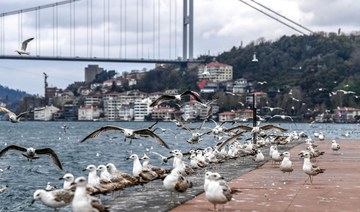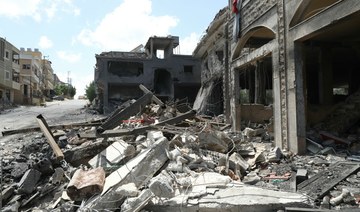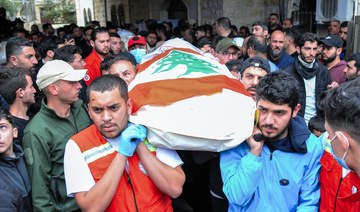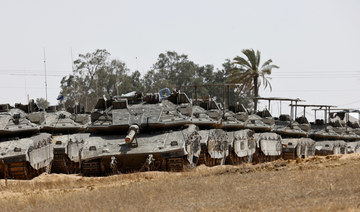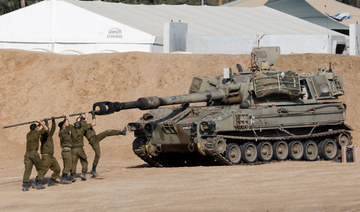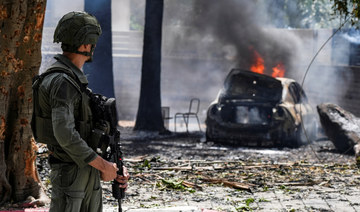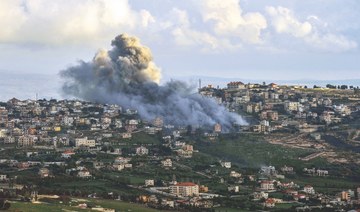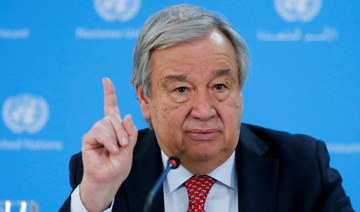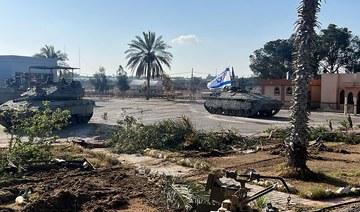ISTANBUL: As cases and deaths soar, Turkey’s president has instructed people to stay home for nearly three weeks and shut down many businesses as part of the country’s strictest COVID-19 measures yet.
President Recep Tayyip Erdogan did not announce a stimulus package to offset the economic impact of the new restrictions.
With Turkey’s double digit inflation, sinking national currency and businesses in trouble, many Turks already have been struggling financially.
Gozde Aslan, a newspaper seller in Istanbul, said the lockdown would be difficult to weather.
“We have to bring food to our homes, and we live in a period where everything is very expensive,” she said. “May God help us.”
Erdogan announced Monday that a “full lockdown” would begin Thursday and last until May 17. Residents will be required to stay home except for grocery shopping and other essential needs, while intercity travel only will be allowed with permission. Restaurants are allowed to deliver food.
Some businesses and industries will be exempt from the shutdown, including factories, agriculture, health care and supply chain and logistics companies.
The Interior Ministry also published a list of exempt individuals, who include parliament members, health care workers, law enforcement officers and many others. Tourists are also exempt from the round-the-clock curfew.
Aslan’s husband and business partner, Baris, said the Turkish government’s decision came late but was correct. He added: “It’s a very difficult decision for the shopkeepers, for the working people. For this, the state should provide great assistance.”
Earlier this month, Erdogan announced an extension of short labor payments for registered workers whose hours were cut due to pandemic restrictions. Some payments previously were made to small businesses.
Shoe store manager Burcin Yilmaz lamented that he would again have to shut his business. During the past three months, several nearby shops that had been open a long time shut down for good, he said.
“We have to close down and wait and see what happens in the end,” Yilmaz said.
Erdogan said daily confirmed cases would have to rapidly drop below 5,000 for Turkey “to not be left behind” as many European countries start reopening.
“Otherwise, we will inevitably face a heavy price in every area, from tourism to trade and education,” the president said. Turkey relies heavily on tourism to bring in foreign currencies.
Opposition lawmakers blasted the government Tuesday. The leader of the main opposition party, Kemal Kilicdaroglu, called on Erdogan to propose a social aid package that would help closed businesses and day laborers in Turkey’s informal economies. He also said urged the suspension of debt enforcement proceedings for some time.
While agreeing with the necessity of a lockdown, Kilicdaroglu said, “People need to eat. They need to live.”
The government has been distributing tons of onions and potatoes this month with much fanfare. Many see it as a clear example of how much Turks are suffering from rising food prices and poverty. The World Bank, in a report published Tuesday, said Turkey’s poverty levels rose from 10.2 percent in 2019 to 12.2 percent in 2020.
In March, the Turkish government split the country into four risk tiers and lifted weekend curfews and allowed indoor dining in many provinces. Coronavirus infections rose again before long, putting most Turkish cities into “very high-risk” categories.
Facing record numbers of confirmed cases, Erdogan in mid-April announced a partial lockdown during the month of Ramadan, bringing back weekend curfews, extending evening curfew hours and closing down restaurants for in-person dining.
Confirmed cases averaged around 60,000 per day during the peak week this month. The country recorded its highest daily death toll on April 21, with 362.
The latest Health Ministry statistics reported Monday showed 37,312 new confirmed cases and 353 deaths. Turkey’s total death toll in the pandemic stands at 38,711.
Full COVID-19 lockdown adds to financial strain in Turkey
https://arab.news/6u5aq
Full COVID-19 lockdown adds to financial strain in Turkey
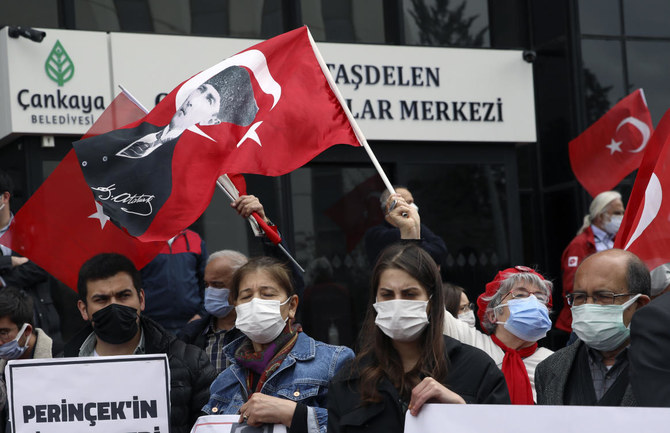
- President Erdogan did not announce a stimulus package to offset the economic impact of the new restrictions
- A newspaper seller in Istanbul said the lockdown would be difficult to weather
Human Rights Watch says Israel attack on Lebanon rescuers was unlawful
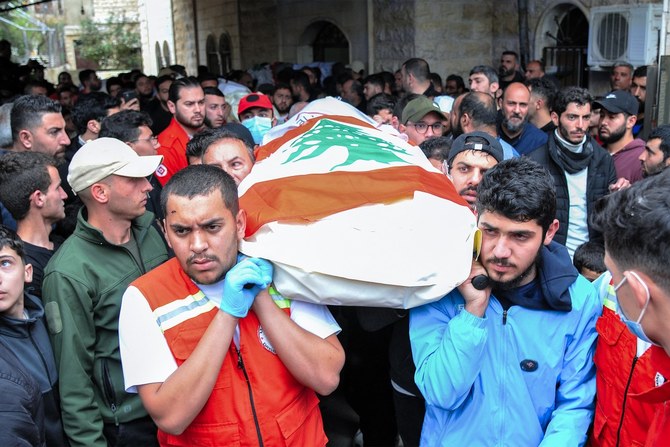
- HRW’s Lebanon researcher Ramzi Kaiss: Israeli forces used a US weapon to conduct a strike that killed seven civilian relief workers in Lebanon who were merely doing their jobs
- Activists from the Gathering of Free University Students organized a demonstration in front of the American University of Beirut campus in support of Palestine and the people of Gaza
BEIRUT: Human Rights Watch on Tuesday said an Israeli strike in Lebanon that killed seven first responders was “an unlawful attack on civilians,” and urged Washington to suspend the sale of weapons to Israel.
“An Israeli strike on an emergency and relief center” in the southern village of Habbariyeh on March 27 “killed seven emergency and relief volunteers,” constituting an “unlawful attack on civilians that failed to take all necessary precautions,” HRW said in a statement.
It said the massacre was committed against “a civil society association that provides emergency services, ambulances, first-aid training, and primary care and relief services in Lebanon.”
Furthermore, HRW said it “did not find any evidence of the presence of military targets at the site that was targeted with the acknowledgment of the Israeli army, which did not take possible precautions to ensure that the target was military … which makes the raid illegal.”
Ramzi Kaiss, HRW’s Lebanon researcher, said: “Israeli forces used a US weapon to conduct a strike that killed seven civilian relief workers in Lebanon who were merely doing their jobs.”
He said the Israeli army used US-made ammunition to carry out the raid.
HRW said it “sent a letter containing the results of reviewing the photos and videos of the site before and after the raid, including a video of the remnants of the ammunition found at the site, and questions to the Israeli army and the US State Department on April 19, but did not receive any response.”
The rights group said it found a metal fragment at the site of the bombing with “MPR 500” written on it, confirming that it is from a 500-pound general-purpose bomb made by Israeli company Elbit Systems, and the fragments and fins are part of a joint direct attack munition set manufactured by American company Boeing.
HRW urged the US to “immediately suspend arms sales and military assistance to Israel given evidence that the Israeli military is using US weapons unlawfully.”
The organization asked Lebanon’s Foreign Ministry to “take immediate action by submitting a declaration to the International Criminal Court, allowing it to investigate crimes falling within its jurisdiction committed on Lebanese territory since October 2023, and prosecute the perpetrators.”
A group of activists from the Gathering of Free University Students organized a demonstration in front of the American University of Beirut campus in support of Palestine and the people of Gaza.
The participants raised a large banner supporting “resistance and boycott until the disintegration of the Israeli entity and the establishment of one Palestine.”
Egypt urges all parties to exert more pressure to end Gaza conflict
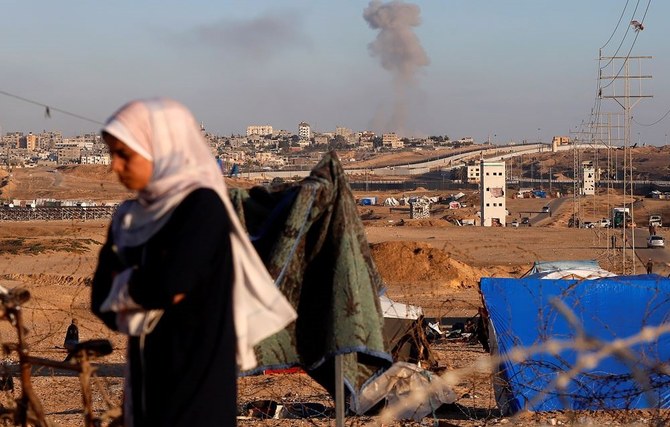
- President Abdel Fattah El-Sisi welcomes progress in recent talks
- Cairo warns Israel that attack on Rafah threatens over 1m in Gaza
CAIRO: Egypt’s President Abdel Fattah El-Sisi has welcomed Monday’s developments in peace talks about finalizing a truce in Israel’s war on Gaza.
El-Sisi said he was “closely following the positive developments pertinent to the ongoing negotiations to reach a comprehensive truce in the Gaza Strip.”
He called on all parties to exert more efforts to reach an agreement that will end the human tragedy of the Palestinian people and finalize the exchange of hostages and prisoners.
Hamas accepted an Egypt-Qatar mediated ceasefire proposal on Monday. The high-stakes diplomatic moves and military brinkmanship left a glimmer of hope alive — but only barely — for an accord that could bring at least a pause in the seven-month-old war that has devastated the Gaza Strip.
An armed conflict between Israel and Hamas-led Palestinian militant groups has been taking place chiefly in and around the Gaza Strip since Oct. 7. It began when Hamas launched a surprise attack on southern Israel from the Gaza Strip, killing around 1,200 people and taking 150 hostages.
Subsequent Israeli strikes against Gaza have driven around 80 percent of the territory’s population of 2.3 million from their homes and caused vast destruction to apartments, hospitals, mosques and schools across several cities.
The Palestinian death toll in Gaza has soared to more than 34,500 people, according to local health officials.
Meanwhile, Egypt’s Foreign Ministry said that it has warned of the dangers of a possible Israeli military operation in Gaza’s Rafah region, “since this escalatory act entails grave humanitarian dangers threatening more than 1 million Palestinians residing in this region.”
It called on Israel to exercise “utmost restraint, and refrain from further escalation at this extremely sensitive timing of ceasefire negotiations, spare the lives of Palestinian civilians who have been enduring an unprecedented humanitarian catastrophe since the outbreak of the war.”
It said that Egypt continues talking with all parties to prevent the situation from deteriorating.
Meanwhile Egypt’s Foreign Minister Sameh Shoukry discussed the Rafah situation with his UAE counterpart Sheikh Abdullah bin Zayed Al-Nahyan in a phone call.
They exchanged views regarding the possibility of Israeli forces carrying out a military operation in the besieged city.
Shoukry reiterated his warning of the dangers of an Israeli military escalation in Rafah, which is considered the last relatively safe area in the Gaza Strip and refuge for more than a million Palestinians.
The ministers stressed the urgency of reaching a truce agreement that allows for the swapping of hostages and detainees, and ensure a permanent ceasefire.
They agreed to continue talks with various parties to prevent the conflict from spreading to the region.
Hezbollah launches ‘explosive-laden drone’ attack on northern Israel
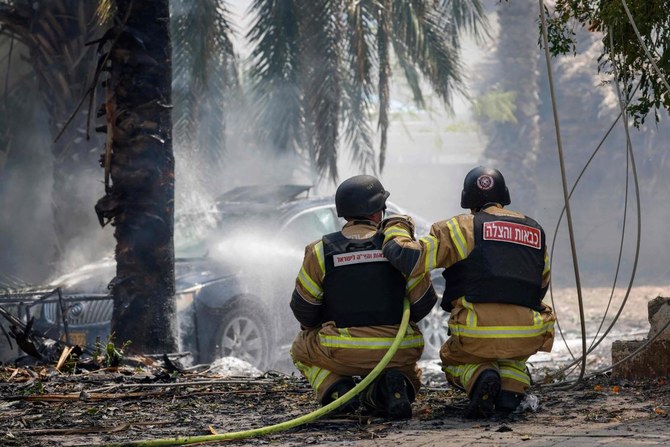
- Hezbollah fighters launched ‘explosive-laden drones targeting enemy soldiers and officers’
- At least 390 people have been killed, in Lebanon, in nearly seven months of cross-border violence
BEIRUT: Lebanon’s Hezbollah said it attacked northern Israel on Tuesday with “explosive-laden drones,” a day after an assault claimed by the Iran-backed movement killed two soldiers there.
Israel and Hezbollah have exchanged regular cross-border fire since Palestinian militant group Hamas’s unprecedented October 7 attack on southern Israel sparked war in the Gaza Strip.
In recent weeks Hezbollah has stepped up its attacks, which it says are in support of Gazans and its ally Hamas, and Israel’s military has struck deeper into Lebanese territory.
Hezbollah fighters on Tuesday launched “explosive-laden drones targeting enemy soldiers and officers,” the group said in a statement.
At the same time, other drones “targeted one of the Iron Dome (air defense system) platforms,” the militants said, adding in separate statements that they carried out other attacks on northern Israel, including with guided missiles.
Israel’s army said on Tuesday that two soldiers had been killed a day earlier in the north.
On Monday, Hezbollah claimed a drone attack on troops near northern Israel’s Metula, with the Israeli military saying “a UAV (drone) was identified crossing from Lebanon” into the area.
In Lebanon, at least 390 people have been killed in nearly seven months of cross-border violence, mostly militants but also more than 70 civilians, according to an AFP tally.
Israel says 13 soldiers and nine civilians have been killed on its side of the border.
Tens of thousands of people have been displaced on both sides.
UN says its access to Gaza’s Rafah crossing ‘denied’ by Israel
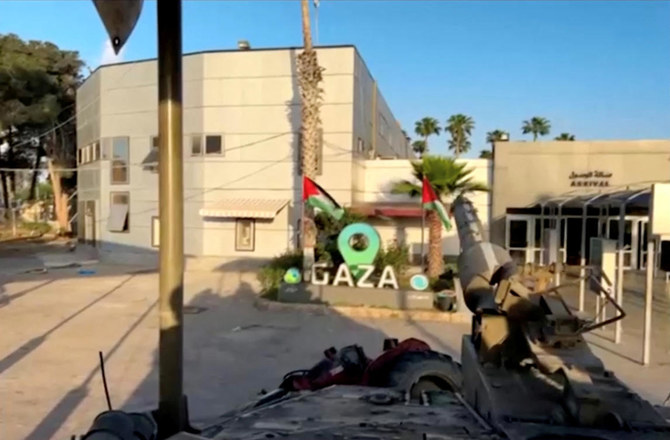
- UN says only has one day of fuel reserves in Gaza
GENEVA: Israeli authorities have denied the UN access to the closed Rafah crossing, the main entry point for humanitarian aid into the Gaza Strip, the United nations said Tuesday .
Jens Laerke, spokesman for the UN’s humanitarian agency OCHA, said there was only a one-day buffer of fuel to run humanitarian operations inside the besieged Palestinian territory.
“We currently do not have any physical presence at the Rafah crossing as our access... has been denied by COGAT,” he said, referring to the Israeli agency that oversees supplies into the Palestinian territories.
“We have been told there will be no crossings of personnel or goods in or out for the time being. That has a massive impact on how much stock do we have.
“There’s a very, very short buffer of one day of fuel available.
“As fuel only comes in through Rafah, the one day buffer is for the entire operation in Gaza.”
If no fuel comes in, “it would be a very effective way of putting the humanitarian operation in its grave,” said Laerke.
“Currently, the two main arteries for getting aid into Gaza are currently choked off,” he said, referring to the Rafah crossing from Egypt and the Kerem Shalom crossing from Israel.
‘Unlike anything we have studied’: Gaza’s destruction in numbers
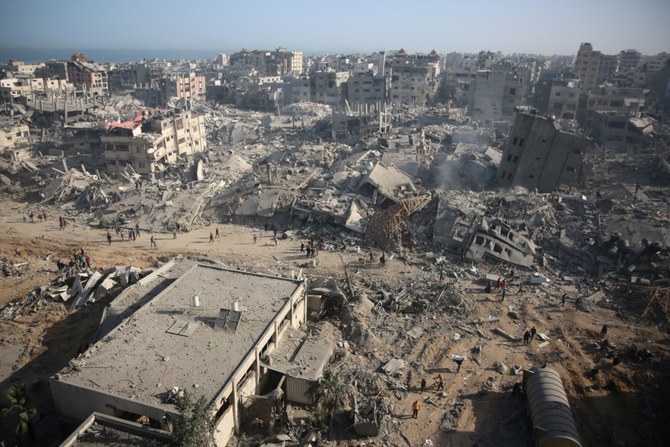
- The level of destruction in northern Gaza has surpassed that of the German city of Dresden, which was firebombed by Allied forces in 1945 in one of the most controversial Allied acts of World War II
Paris: As well as killing more than 34,000 people and causing catastrophic levels of hunger and injury, the seven-month war between Israel and Hamas has also caused massive material destruction in Gaza.
“The rate of damage being registered is unlike anything we have studied before. It is much faster and more extensive than anything we have mapped,” said Corey Scher, a PhD candidate at the City University of New York, who has been researching satellite imagery of Gaza.
As Israel launches an offensive on Rafah, the last population center in Gaza yet to be entered by its ground troops, AFP looks at the territory’s shattered landscape seven months into the war sparked by Hamas’s unprecedented October 7 attack.
Gaza is one of the most densely populated places on the planet, where before the war 2.3 million people had been living on a 365-square-kilometer strip of land.
According to satellite analyzes by Scher and Jamon Van Den Hoek, an associate professor of geography at Oregon State University, 56.9 percent of Gaza buildings were damaged or destroyed as of April 21, totaling 160,000.
“The fastest rates of destruction were in the first two to three months of the bombardment,” Scher told AFP.
In Gaza City, home to some 600,000 people before the war, the situation is dire: almost three-quarters (74.3 percent) of its buildings have been damaged or destroyed.
During the war, Gaza’s hospitals have been repeatedly attacked by Israel, which accuses Hamas of using them for military purposes, a charge the militant group denies.
In the first six weeks of the war sparked by the Hamas attack, which killed more than 1,170 people according to an AFP tally of Israeli official figures, “60 percent of health care facilities... were indicated as damaged or destroyed,” Scher said.
The territory’s largest hospital, Al-Shifa in Gaza City, was targeted in two offensives by the Israeli army, the first in November, the second in March.
The World Health Organization said the second operation reduced the hospital to an “empty shell” strewn with human remains.
Five hospitals have been completely destroyed, according to figures compiled by AFP from the OpenStreetMap project, the Hamas health ministry and the United Nations Satellite Center (UNOSAT). Fewer than one in three hospitals — 28 percent — are partially functioning, according to the UN.
The territory’s largely UN-run schools, where many civilians have sought refuge from the fighting, have also paid a heavy price.
As of April 25, UNICEF counted 408 schools damaged, representing at least 72.5 percent of its count of 563 facilities.
Of those, 53 school buildings have been completely destroyed and 274 others have been damaged by direct fire.
The UN estimates that two-thirds of the schools will need total or major reconstruction to be functional again.
Regarding places of worship, combined data from UNOSAT and OpenStreetMap show 61.5 percent of mosques have been damaged or destroyed.
The level of destruction in northern Gaza has surpassed that of the German city of Dresden, which was firebombed by Allied forces in 1945 in one of the most controversial Allied acts of World War II.
According to a US military study from 1954, quoted by the Financial Times, the bombing campaign at the end of World War II damaged 59 percent of Dresden’s buildings.
In late April, the head of the UN mine clearance program in the Palestinian territories, Mungo Birch, said there was more rubble to clear in Gaza than in Ukraine, which was invaded by Russia more than two years ago.
The UN estimated that as of the start of May, the post-war reconstruction of Gaza would cost between 30 billion and 40 billion dollars.



